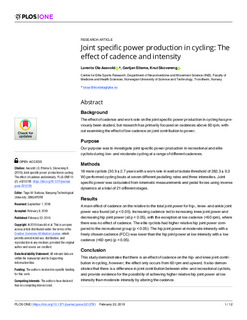| dc.contributor.author | Aasvold, Lorents Ola | |
| dc.contributor.author | Ettema, Gertjan | |
| dc.contributor.author | Skovereng, Knut | |
| dc.date.accessioned | 2019-05-23T05:59:36Z | |
| dc.date.available | 2019-05-23T05:59:36Z | |
| dc.date.created | 2019-05-22T11:27:06Z | |
| dc.date.issued | 2019 | |
| dc.identifier.issn | 1932-6203 | |
| dc.identifier.uri | http://hdl.handle.net/11250/2598495 | |
| dc.description.abstract | Background
The effect of cadence and work rate on the joint specific power production in cycling has previously been studied, but research has primarily focused on cadences above 60 rpm, without examining the effect of low cadence on joint contribution to power.
Purpose
Our purpose was to investigate joint specific power production in recreational and elite cyclists during low- and moderate cycling at a range of different cadences.
Methods
18 male cyclists (30.9 ± 2.7 years with a work rate in watt at lactate threshold of 282.3 ± 9.3 W) performed cycling bouts at seven different pedalling rates and three intensities. Joint specific power was calculated from kinematic measurements and pedal forces using inverse dynamics at a total of 21 different stages.
Results
A main effect of cadence on the relative to the total joint power for hip-, knee- and ankle joint power was found (all p < 0.05). Increasing cadence led to increasing knee joint power and decreasing hip joint power (all p < 0.05), with the exception at low cadence (<60 rpm), where there was no effect of cadence. The elite cyclists had higher relative hip joint power compared to the recreational group (p < 0.05). The hip joint power at moderate intensity with a freely chosen cadence (FCC) was lower than the hip joint power at low intensity with a low cadence (<60 rpm) (p < 0.05).
Conclusion
This study demonstrates that there is an effect of cadence on the hip- and knee joint contribution in cycling, however, the effect only occurs from 60 rpm and upward. It also demonstrates that there is a difference in joint contribution between elite- and recreational cyclists, and provide evidence for the possibility of achieving higher relative hip joint power at low intensity than moderate intensity by altering the cadence. | nb_NO |
| dc.language.iso | eng | nb_NO |
| dc.publisher | PLOS, Public Library of Science | nb_NO |
| dc.relation.uri | https://journals.plos.org/plosone/article?id=10.1371/journal.pone.0212781 | |
| dc.rights | Navngivelse 4.0 Internasjonal | * |
| dc.rights.uri | http://creativecommons.org/licenses/by/4.0/deed.no | * |
| dc.title | Joint specific power production in cycling: The effect of cadence and intensity | nb_NO |
| dc.type | Journal article | nb_NO |
| dc.type | Peer reviewed | nb_NO |
| dc.description.version | publishedVersion | nb_NO |
| dc.source.journal | PLoS ONE | nb_NO |
| dc.identifier.doi | https://doi.org/10.1371/journal.pone.0212781 | |
| dc.identifier.cristin | 1699437 | |
| dc.description.localcode | © 2019 Aasvold et al. This is an open access article distributed under the terms of the Creative Commons Attribution License, which permits unrestricted use, distribution, and reproduction in any medium, provided the original author and source are credited. | nb_NO |
| cristin.unitcode | 194,65,30,0 | |
| cristin.unitname | Institutt for nevromedisin og bevegelsesvitenskap | |
| cristin.ispublished | true | |
| cristin.fulltext | original | |
| cristin.qualitycode | 1 | |

